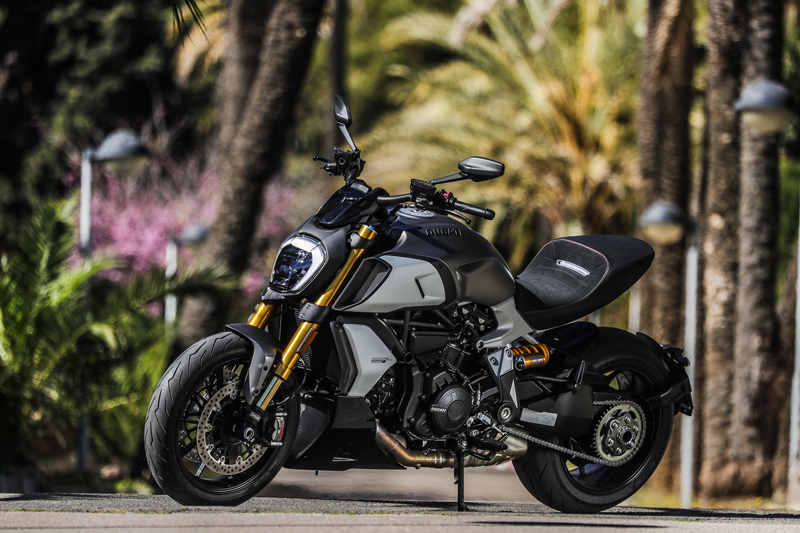2019 Ducati Diavel 1260 S

First Ride Review
It’s big, muscular, powerful and aggressive, a styling mish-mash of crouching naked bike, sleek superbike and long, low cruiser, nicknamed–and then officially dubbed–by its creators: Diavel (“devil” in the local Bolognese dialect, where the Ducati factory is located).
Loathe to classify it with the c-word (cruiser), Ducati calls it a “disruptor,” which sounds plausible enough despite a bit of uncertainty as to exactly what market segment the Diavel is disrupting. Based on buyer demographics, that segment could be called “early-middle-aged guys who like to go fast on curvy roads but don’t want to fold themselves onto a superbike anymore.” I’m not a middle-aged man but the rest sounds good to me, and disrupting others’ expectations is kinda my hobby so…hello, dark prince.
The original Diavel, launched in 2011 and powered by the 1,198cc Testastretta L-twin borrowed from the Multistrada 1200, left us “with more questions than answers” but delivered a “mind-bending,” superbike-inspired riding experience (read the full review here). With chain final drive, mid-mount controls, a 28-degree rake, a 30.3-inch seat, a massive 240mm Pirelli Diablo Rosso II rear tire, headers that swooped and curled from the cylinders and a full suite of electronics, the Diavel was tough to define.
It took a decidedly power cruiser turn when the XDiavel variation was added to the lineup in 2016, raked out to 30 degrees and with a belt final drive, forward controls, a slightly lower seat and relocated front-mount radiator, the better to show off the new 1,262cc DVT L-twin that would make its way into the Multistrada 1260 and 1260 Enduro in 2018.
For 2019, Ducati has redressed the original sin(ner), giving the Diavel a complete redesign that includes the larger engine and a more streamlined, yet still muscular look. Nearly everything on the Diavel 1260 is new, including the frame, subframe, swingarm, wheels, fuel tank, silencers, suspension, tail section, engine covers and bodywork. Even that massive rear tire is the new Pirelli Diablo Rosso III, which has a new profile said to aid turn-in. Rake has been tightened to 27 degrees and the wheelbase stretches 63 inches, midway between the previous Diavel and the XDiavel (which returns unchanged for 2019).
I could never quite wrap my heart around the look of the original, but what at first glance appear to be minor styling changes add up to a much more attractive bike, at least in my eyes. New stubby silencers don’t interfere with the rear wheel, whether you’re servicing it or simply admiring it. Front-mounted radiator shrouds and belly pan hug the front wheel like a superbike, and the tail has been streamlined with flush-mounted LED lights and a new, wider rider and passenger seat; the clever retracting grab rail returns, although passenger pegs are now in a more conventional, fixed position.
Up front is a headlight with LED daytime running light (S model only) and full-color 3.5-inch TFT display as seen on the XDiavel, plus very cool (and bright!) integrated LED turn indicators with the “light blade” technology used on Audi automobiles (the Volkswagen group, you may recall, owns Ducati).
Suspension on the $19,995 standard model includes a fully adjustable 50mm USD fork and preload/rebound adjustable rear shock, while brakes are radially mounted Brembo monoblock 4-piston M4.32 calipers squeezing two 320mm discs, and a 2-piston Brembo floating caliper with 265mm disc at the rear; Bosch Cornering ABS Evo is standard. On the $22,995 S model we tested, suspension is upgraded to a 48mm Öhlins fork and Öhlins monoshock, both fully adjustable, and the front calipers are top-of-the-line Brembo M50s that stop the bike pronto.
Both models include a full suite of electronics: three rider-customizable riding modes (Sport, Touring and Urban), the Ducati Safety Pack (Bosch Cornering ABS Evo and Ducati Traction Control Evo), Ducati Wheelie Control, Ducati Power Launch Evo, cruise control, backlit switchgear and self-cancelling indicators. The S adds Ducati Quick Shift Up/Down Evo and compatibility with the Ducati Multimedia System and Ducati Link App (all of which is available optionally on the base model).
Let’s face it though, on a bike named “devil,” the engine is king, and you can do a whole lotta sinnin’ with this one. The Testrastretta DVT 1262 L-twin doles out 145 smooth rear-wheel horsepower and 85.3 lb-ft of torque per the Jett Tuning dyno when we tested the XDiavel back in May 2016. Full power is available in both Sport and Touring modes, although I found throttle response to be a bit too abrupt in Sport, and used Touring mode everywhere except on bumpy, tight city streets where Urban worked best. It cuts max power to 98 and torque to 64 per our test, but all three modes can be customized with power, ABS, traction control and wheelie control settings.
I didn’t mess with the standard Touring mode settings, simply enjoying the sinful rush of acceleration and howling roar as we tore through the rocky, hilly countryside at the press launch in Southern Spain. The 538-pound (claimed) Diavel was relatively easy to handle on the endless curves, although in parking lots the long wheelbase, limited turning radius and wide handlebar necessitated some effort and concentration. The long, bulging 4.5-gallon fuel tank gives the impression of a superhero’s flying reach to the grips, but in reality the ergos put the rider into just a slight forward lean that’s quite comfortable, with feet solidly on the mid-mount pegs and butt planted in the scooped-out, 30.7-inch seat.
On most bikes with a fat rear tire and even a whiff of cruiser-ness, handling is secondary to looks, but this is a Ducati. Flickable it isn’t, but in the hands of an experienced rider the Diavel will give most sportbikes a run for their money, and the upshot of the solid chassis, low center of gravity, long wheelbase and thick rubber is stability that encourages the rider to drink deeply of the Testastretta’s intoxicating power. This is a bike that likes to be ridden hard and fast; let the revs drop below 3,000 rpm and the engine lugs in protest. Keep that throttle open and the revs spinning, and you’ll be rewarded with worldly pleasures. As Ducati says, it’s so good to be bad.
At 8 years old, the Diavel is still genre defying and, honestly, very much a niche motorcycle. But this latest iteration is, in my opinion, the best one yet, so if you’re the type who likes to march to your own beat and forge your own identity, this disruptor might be exactly what you’re looking for.
